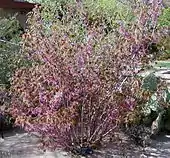Ungnadia
Ungnadia is a genus of flowering plants in the family Sapindaceae containing one species, Ungnadia speciosa, the Mexican buckeye. It is native to northern Mexico, as well as Texas and southern New Mexico in the United States.[1][2] The name honours Austrian ambassador Baron David von Ungnad, who brought the horse chestnut to Vienna in 1576, introducing the plant into western Europe.[3][4][5][6]
| Mexican buckeye | |
|---|---|
 | |
| Mexican Buckeye flowers | |
| Scientific classification | |
| Kingdom: | Plantae |
| Clade: | Tracheophytes |
| Clade: | Angiosperms |
| Clade: | Eudicots |
| Clade: | Rosids |
| Order: | Sapindales |
| Family: | Sapindaceae |
| Subfamily: | Sapindoideae |
| Genus: | Ungnadia Endl.[1] |
| Species: | U. speciosa |
| Binomial name | |
| Ungnadia speciosa Endl.[2] | |
 | |
| Natural range | |

It differs from the buckeyes in the related genus Aesculus but the seeds and nuts are similar.[7][5][8][9] Another similar related genus is the soapberry (genus Sapindus). Ungnadia seeds are poisonous despite their sweetness, and sometimes used as marbles.[10] The foliage is toxic and rarely browsed by livestock, but bees produce honey from the floral nectar.[5]
Description
Ungnadia speciosa a deciduous shrub or small tree (< 25 ft) that is often multi trunked. The leaves (5 – 12 in) are alternate and pinnately compound with 5 - 9 leaflets. The leaflets are long (3 – 5 in), narrow, and pointed with slight serrations.[11][5]
References
- "Ungnadia Endl". Germplasm Resources Information Network. United States Department of Agriculture. 2006-03-29. Retrieved 2010-01-19.
- "Ungnadia speciosa". Germplasm Resources Information Network (GRIN). Agricultural Research Service (ARS), United States Department of Agriculture (USDA). Retrieved 2013-05-14.
- Quattrocchi, Umberto (2000). CRC World Dictionary of Plant Names. Vol. 4 R-Z. Taylor & Francis US. p. 2760. ISBN 978-0-8493-2678-3.
- Endlicher, Stephan (1841). Enchiridion botanicum, exhibens classes et ordines plantarum accedit nomenclator generum et officinalium vel usualium indicatio. Lipsiae,Sumptibus G. Engelmann. p. 565.
- Little, Elbert L. (1994) [1980]. The Audubon Society Field Guide to North American Trees: Western Region (Chanticleer Press ed.). Knopf. p. 544. ISBN 0394507614.
- Endlicher, Stephan (1839). Novarum stirpium decas I-X. Vindobonae :Typis Sollingerianis. p. 75.
- Young, James A.; Young, Cheryl G. (2009). Seeds of Woody Plants in North America. Dioscorides Press. ISBN 978-1604691122.
- Bonner, Franklin T.; Karrfalt, Robert P., eds. (2008). The Woody Plant Seed Manual. Agric. Handbook No. 727. Washington, DC.: U.S. Department of Agriculture, Forest Service.
- Burns, Russell M.; Honkala, Barbara H., eds. (1990). Silvics of North America. Agric. Handbook No. 654. Washington, DC.: U.S. Department of Agriculture, Forest Service.
- Stahl, Carmine; McElvaney, Ria (2003). Trees of Texas. College Station, TX: Texas A&M Press. ISBN 978-1-60344-515-3.
- Nokes, Jill (2001). How to Grow Native Plants of Texas and the Southwest. Austin, TX: University of Texas Press. ISBN 978-0292755734.
External links
![]() Media related to Ungnadia at Wikimedia Commons
Media related to Ungnadia at Wikimedia Commons
![]() Data related to Ungnadia speciosa at Wikispecies
Data related to Ungnadia speciosa at Wikispecies